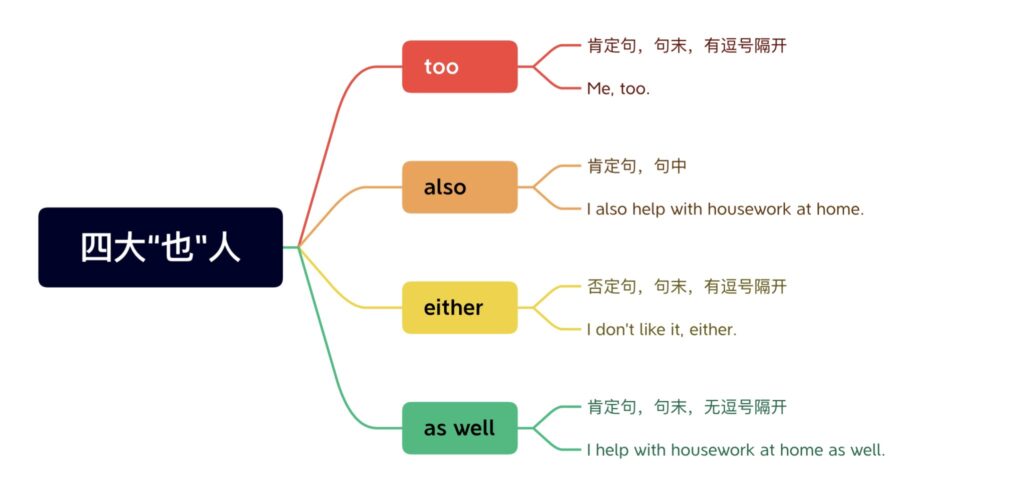定义
1. too: 表达“也”的肯定情况,常用于肯定句的结尾,一般有逗号隔开。
例句:She speaks French, too.
2. either: 表达“也”的否定情况,常用于否定句的结尾,有逗号隔开。
例句:I can’t speak Italian, either.
3. also: 表达“也”的肯定情况,用于句中。
例句:She also speaks Chinese.
4. as well: 表达“也”的肯定情况,用于句末语气更加温和,无逗号隔开。
例句:She can swim as well.
补充:”也“的简要表达:So do I. & Neither do I.
“So do I” 和 “Neither do I” 是英语中常用的表示否定或肯定的方式。它们一般用于回答肯定/否定的问题,以确认说话人是否有相同的想法或感受。
“So do I” 用于回答肯定的陈述句,表示自己也是同意者。
例如,如果某人说:“I love listening to music.”(我喜欢听音乐),回答者赞同这个陈述可以说:“So do I.”(我也是)。
请注意,”So do I” 中的 “So” 用于引出和重复之前的陈述句,而 “do” 是用来代表前面陈述句的动词。
“Neither do I” 用于回答否定的陈述句,表示自己也赞同。
例如,如果某人说:“I don’t like spicy food.”(我不喜欢吃辣的),回答者也不喜欢可以说:“Neither do I.”(我也不喜欢)。
“Neither do I” 同样可以用于肯定陈述句的否定回答,如:”I have never been to Paris.”(我从未去过巴黎)可以回答:“Neither have I.”(我也没有去过)。
需要注意的是,答案中的动词需要和前面所说的陈述句中的动词保持一致。此外,如果前面的陈述句使用了否定词,如 “not”,在回答时需要将其保留在回答中。
Mindmap解析

习题-Exercises
Fill in the blanks with also, too, either, as well, so, neither.
1. I ______ like jazz music.
2. She doesn’t like spicy food, ______ don’t I.
3. He’s not only intelligent but ______ very handsome.
4. Do you want tea or coffee? I’ll have ______.
5. She ______ likes swimming and running.
6. I don’t eat meat and ______ doesn’t my sister.
7. He speaks Spanish ______ as Portuguese.
8. The concert tickets are sold out, and ______ the theater performance.
9. I hate horror movies, and ______ does my roommate.
10. They are both doctors, ______.
答案:
1. also
2. neither
3. also
4. either
5. as well
6. neither
7. as well
8. also
9. so/ neither
10. too